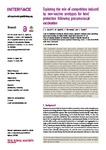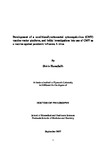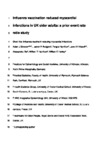Exploring the role of competition induced by non-vaccine serotypes for herd protection following pneumococcal vaccination
| dc.contributor.author | masala, giovanni | |
| dc.contributor.author | Lipsitch, M | |
| dc.contributor.author | Bottomley, C | |
| dc.contributor.author | Flasche, S | |
| dc.date.accessioned | 2018-10-06T09:35:49Z | |
| dc.date.available | 2018-10-06T09:35:49Z | |
| dc.date.issued | 2017-11-01 | |
| dc.identifier.issn | 1742-5662 | |
| dc.identifier.issn | 1742-5662 | |
| dc.identifier.uri | http://hdl.handle.net/10026.1/12465 | |
| dc.description | open access | |
| dc.description.abstract |
The competitive pressure from non-vaccine serotypes may have helped pneumococcal conjugate vaccines (PCVs) to limit vaccine-type (VT) serotype prevalence. We aimed to investigate if, consequently, the indirect protection of vaccines targeting most pneumococcal serotypes could fall short of the profound effects of current formulations. We compared three previously described pneumococcal models harmonized to simulate 20 serotypes with a combined pre-vaccination prevalence in children younger than 5-years-old of 40%. We simulated vaccines of increasing valency by adding serotypes in order of their competitiveness and explored their ability to reduce VT carriage by 95% within 10 years after introduction. All models predicted that additional valency will reduce indirect vaccine effects and hence the overall vaccine impact on carriage both in children and adults. Consequently, the minimal effective coverage (efficacy against carriage×vaccine coverage) needed to eliminate VT carriage increased with increasing valency. One model predicted this effect to be modest, while the other two predicted that high-valency vaccines may struggle to eliminate VT pneumococci unless vaccine efficacy against carriage can be substantially improved. Similar results were obtained when settings of higher transmission intensity and different PCV formulations were explored. Failure to eliminate carriage as a result of increased valency could lead to overall decreased impact of vaccination if the disease burden caused by the added serotypes is low. Hence, a comparison of vaccine formulations of varying valency, and pan-valent formulations in particular, should consider the invasiveness of targeted serotypes, as well as efficacy against carriage. | |
| dc.format.extent | 20170620-20170620 | |
| dc.format.medium | ||
| dc.language | en | |
| dc.language.iso | en | |
| dc.publisher | Royal Society, The | |
| dc.subject | herd protection | |
| dc.subject | pneumococcus | |
| dc.subject | serotype competition | |
| dc.subject | vaccination | |
| dc.subject | Humans | |
| dc.subject | Immunity, Herd | |
| dc.subject | Models, Immunological | |
| dc.subject | Pneumococcal Vaccines | |
| dc.subject | Streptococcus pneumoniae | |
| dc.subject | Vaccination | |
| dc.title | Exploring the role of competition induced by non-vaccine serotypes for herd protection following pneumococcal vaccination | |
| dc.type | journal-article | |
| dc.type | Journal Article | |
| dc.type | Research Support, N.I.H., Extramural | |
| dc.type | Research Support, Non-U.S. Gov't | |
| plymouth.author-url | https://www.ncbi.nlm.nih.gov/pubmed/29093131 | |
| plymouth.issue | 136 | |
| plymouth.volume | 14 | |
| plymouth.publication-status | Published | |
| plymouth.journal | Journal of the Royal Society Interface | |
| dc.identifier.doi | 10.1098/rsif.2017.0620 | |
| plymouth.organisational-group | /Plymouth | |
| plymouth.organisational-group | /Plymouth/Faculty of Science and Engineering | |
| plymouth.organisational-group | /Plymouth/REF 2021 Researchers by UoA | |
| plymouth.organisational-group | /Plymouth/REF 2021 Researchers by UoA/UoA11 Computer Science and Informatics | |
| dc.publisher.place | England | |
| dcterms.dateAccepted | 2017-10-11 | |
| dc.identifier.eissn | 1742-5662 | |
| dc.rights.embargoperiod | Not known | |
| rioxxterms.versionofrecord | 10.1098/rsif.2017.0620 | |
| rioxxterms.licenseref.uri | http://www.rioxx.net/licenses/all-rights-reserved | |
| rioxxterms.licenseref.startdate | 2017-11-01 | |
| rioxxterms.type | Journal Article/Review |




